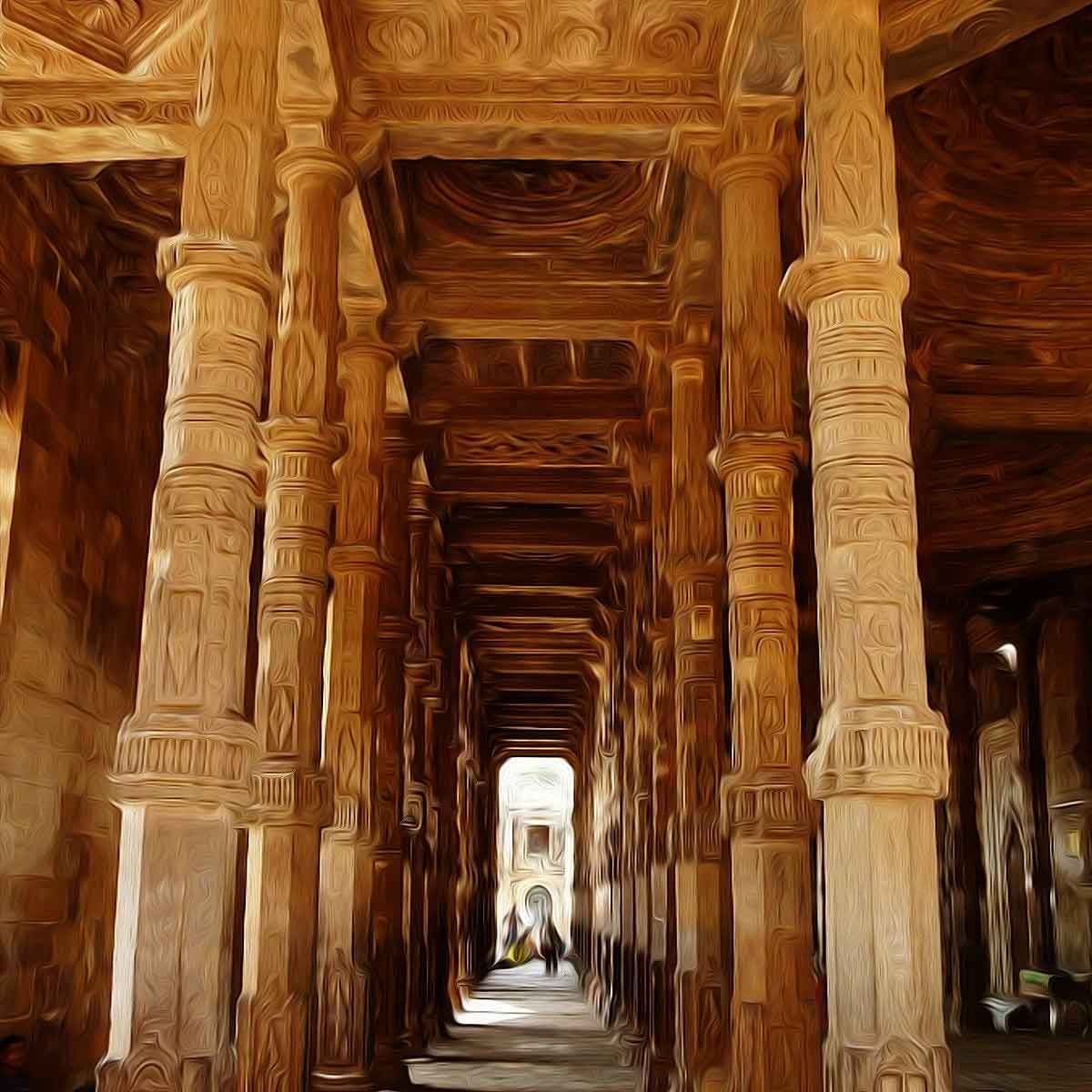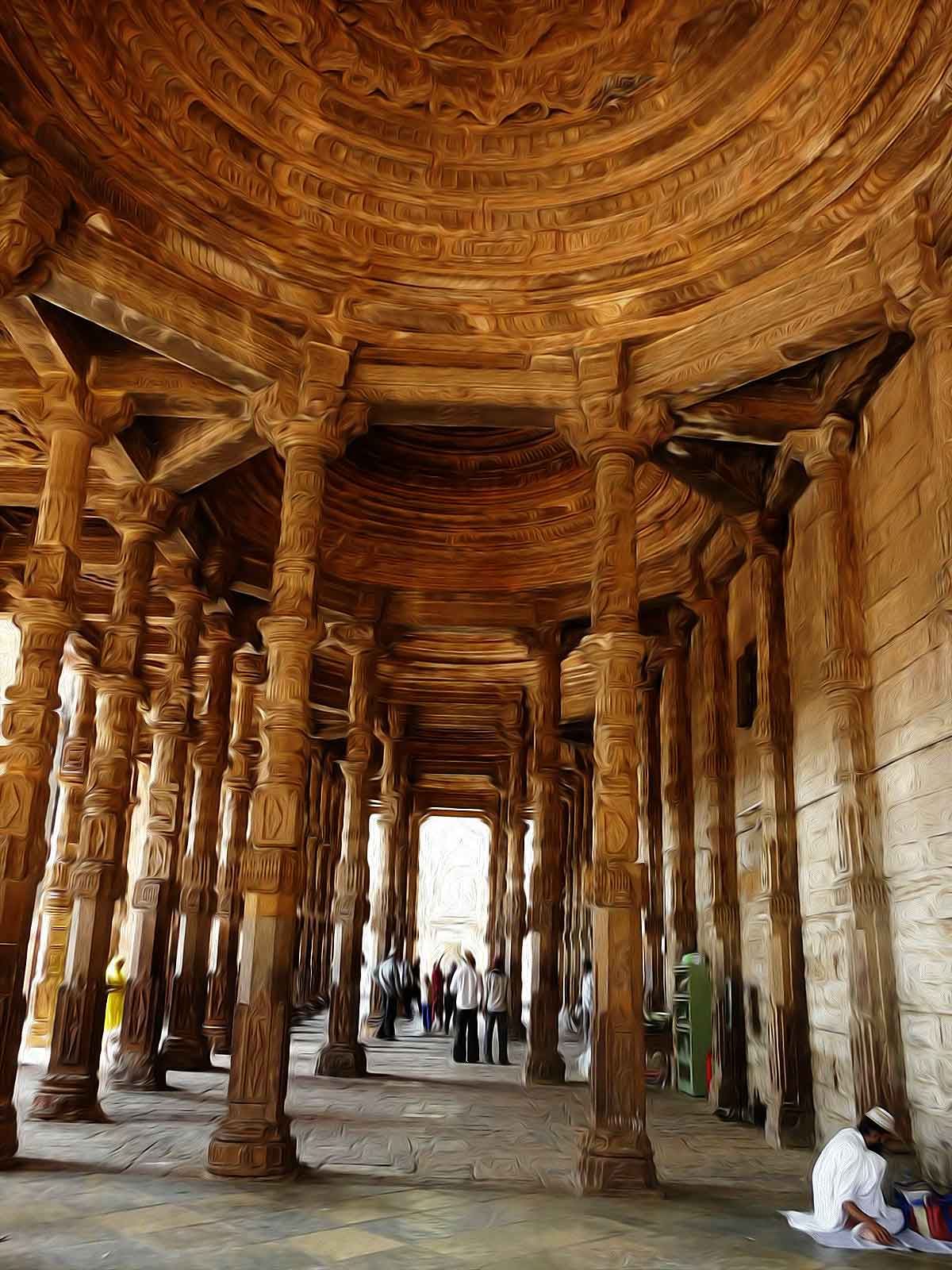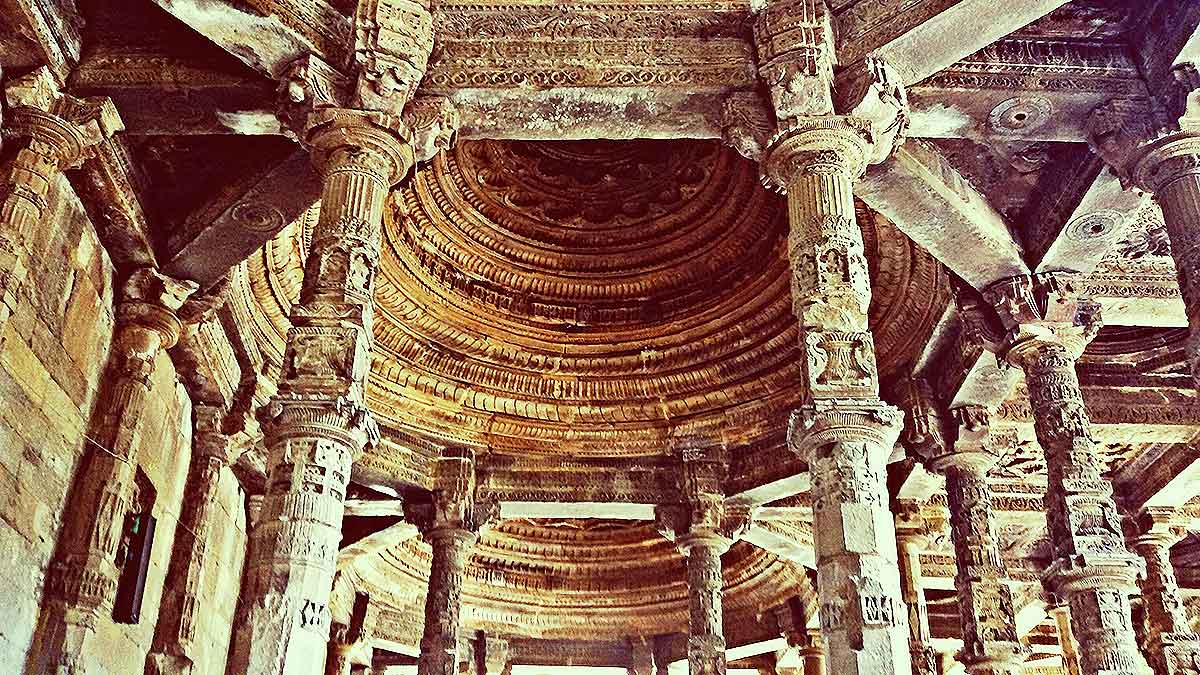More Coverage
Twitter Coverage
Satyaagrah
Written on
Satyaagrah
Written on
Satyaagrah
Written on
Satyaagrah
Written on
Satyaagrah
Written on
Join Satyaagrah Social Media
Rajasthan: Oldest mosque of Ajmer ‘Adhai Din Ka Jhonpra’ stands over ruins of a magnificent Sanskrit pathshala 'Saraswati Kanthabharan Mahavidyalay': Hindu and Jain temple features found, structure still used by Muslims for Namaz

The rich culture of Indian civilization was destroyed by the Islamic invaders for centuries. One of the oldest examples of the atrocities that were faced in the hands of Mughals is Adhai Din Ka Jhonpra, which literally means ‘Shed of two and half days. In the city of Ajmer, Rajasthan, the mosque ‘Adhai Din Ka Jhonpra’ stands tall under the supervision of the Archaeological Survey of India (ASI).
Though it is visited by hundreds of tourists, the structure is still used by Muslims for Namaz. To understand how it is clear evidence of Islamic atrocities, it is essential to tell its story and what one may find on visiting the site.
History of Adhai Din Ka Jhonpra
Originally a magnificent Sanskrit College (Saraswati Kanthabharan Mahavidyalay) with a temple dedicated to Mata Saraswati, the Hindu Goddess of Knowledge and Wisdom, the building was commissioned by Maharaja Vigraharaja IV. He was a king of the Shakambhari Chahamana or Chauhan dynasty.
As per several documents, the original building was square-shaped. It had a tower at each corner. There was a temple of Mata Sarawati on the western side of the building. In the 19th century, a tablet was found at the site that dated back to 1153 CE. Experts believe that based on the tablet, it can be inferred that the original building was constructed sometime around 1153.
Some local Jain legends, however, state that the building was commissioned by Seth Viramdeva Kala in 660 CE. It was constructed as a Jain Shrine and celebrated Panch Kalyanaka. It is noteworthy that the site has elements of both Jain and Hindu architecture of that time.
 Adhai Din Ka Jhonpra, Ajmer was a magnificent Jain temple, until Islamic invader Ghori converted it into a Masjid |
The conversion into a mosque
As the story goes, in 1192 CE, Muhammad Ghori defeated Maharaja Prithviraj Chouhan and took over Ajmer. He ordered his slave general Qutb-ud-Din-Aibak to destroy temples in the city. The legend said he had ordered Aibak to construct a prayer section of the mosque on the temple site within 60 hours so that he could pray. That attributes to the name ‘Adhai Din Ka Jhonpra’. However, some experts believe that it was just a legend, and it took several years to complete the construction of the mosque. The name, according to them, came from the two-and-a-half-day fare that takes place in the mosque every year.
There is an inscription at the central mihrab of the mosque that mentions the date of completion as Jumada II 595 AH that converts to April 1199 CE of the English calendar. Later, Qutb-ud-Din-Aibak’s successor Iltutmish beautified the mosque in 1213 CE. He added a screen wall in the mosque. There is an inscription of his name on the northern minaret along with the construction supervisor Ahmed ibn Muhammad al-Arid’s name on the south arch.
Notably, it is not easy to differentiate which part of the mosque was originally a Saraswati Temple and Sanskrit School as ruins from around 25-30 Hindu and Jain temples were used in the construction of the mosque.
 Built-in 12th century, Adhai Din Ka Jhonpra was built over the demolished ruins of a Sanskrit College and Saraswati Temple site |
Sita Ram Goel’s report on the mosque
Famous Historian Sita Ram Goel mentioned the mosque in his book ‘Hindu Temples: What Happened To Them’. He attributed to the book ‘Asar-Us-Sanadid’ by author Syed Ahmad Khan in which he had mentioned that the mosque of Ajmer, i.e. Adhai Din Ka Jhonpra, was constructed using the materials from Hindu temples.
Alexander Cunningham’s report on the mosque
Alexander Cunningham, who was commissioned as Director-General of ASI in 1871, presented a detailed account of the mosque in ‘Four Reports Made During the Years, 1862-63-64-65’. He mentioned that upon inspecting the site, he found that it was built with the ruins of many Hindu temples. He said, “Its very name ‘Adhai Din Ka Jhopra would seem to point directly to the astonishing rapidity of its erection, and as this could only have been affected by the free use of the ready dressed materials of prostrated Hindu temples.”
 Four Reports Made During the Years, 1862-63-64-65, Volume 2 By Alexander Cunningham/Google Books |
Cunningham further attributed James Tod, a Lieutenant-Colonel of the British empire who had visited the mosque, in the report. Tod had said that the whole building could have been originally a Jain Temple. However, he also found many pillars with four-handed figures on them that could not have been Jain by nature. Beside those sculptures, there was a single figure of Goddess Kali.
 Four Reports Made During the Years, 1862-63-64-65, Volume 2 By Alexander Cunningham/Google Books |
He added, “Altogether, there were 344 pillars, but each of these represented at least two of the original pillars. The actual number of Hindu columns could not have been less than 700, which is equivalent to the spoils of from 20 to 30 temples.”
 Four Reports Made During the Years, 1862-63-64-65, Volume 2 By Alexander Cunningham/Google Books |
As per reports, till the 1990s, there were several ancient Hindu sculptures scattered inside the mosque. In the 90s, the ASI moved them to a secure location to preserve them. How the sculptures were preserved was explained by a Twitter user who recently visited the place.
In a tweet thread, Twitter user Dharmik Stance clicked a few photographs of a closed room inside the premises. He said, “Some rooms have been sealed by ASI on the premises. Have a look at what I saw from the cracks.” The photographs and video added by the Twitter user show the sorry state of the ancient sculptures inside those rooms.
|
The video and photographs were clicked in March 2022. Upon zooming in on the photographs, one can clearly see the sculptures of Hindu origin. One of the stones in the room can be seen marked by ASI as AJR5 AJP/92/99.
 One of the oldest examples of the atrocities that were faced in the hands of Mughals is Adhai Din Ka Jhonpra |
Other mentions by netizens
In 2015, the popular handle ‘Reclaim Temples’ posted about the mosque and wrote, “Adhai Din Ka Jhonpra, Ajmer was a magnificent Jain temple, until Islamic invader Ghori converted it into a Masjid.”
|
Another Twitter user neutr0nium published a thread on the mosque. He mentioned that it was ignored for a long time after conversion into a mosque and renovated by Maratha king Daulat Rao Sindhia in the 18th century. However, it remained a mosque. In 1947, ASI took control of the site.
|
He mentioned that the site does not have any information boards placed by ASI explaining its history. He said, “ASI board just stats that it’s a mosque constructed by Qutubdin and the oldest surviving monument of AJMER.” It is unfortunate that despite being clearly a site that was previously a Sanskrit School and a Hindu and Jain temple, ASI failed to mention the history anywhere at the site and attributed it just to a mosque.
|
Author Sanjay Dixit wrote, “Adhai Din Ka Jhonpra mosque in Ajmer is an early instance of demolition of temples. Built at the instance of the Sufi saint Moinuddin Chishti, allegedly peaceful and secular, by razing a temple of goddess Sarasvati and a Vidyapeeth by Qutubuddin Aibak after Prithviraj’s defeat.”
|
The painful history of Hindu temples razed to build mosques
There are thousands of sites across India where mosques and other Muslim structures were built after destroying temples. These structures were built using temple materials and/or stand on temple sites. Babri Mosque (handed back to Hindus to build Bhavya Ram Mandir), Gyanvapi Mosque (disputed structure in Varanasi), and Shahi Idgah (disputed structure of Mathura residing inside Krishna Temple complex) are some of the prime examples. Historian Sita Ram Goel has documented around 1,800 such sites in his book Hindu Temples: What Happened To Them. A brief about the book can be read here.
References:
opindia.com
 Support Us
Support Us
Satyagraha was born from the heart of our land, with an undying aim to unveil the true essence of Bharat. It seeks to illuminate the hidden tales of our valiant freedom fighters and the rich chronicles that haven't yet sung their complete melody in the mainstream.
While platforms like NDTV and 'The Wire' effortlessly garner funds under the banner of safeguarding democracy, we at Satyagraha walk a different path. Our strength and resonance come from you. In this journey to weave a stronger Bharat, every little contribution amplifies our voice. Let's come together, contribute as you can, and champion the true spirit of our nation.
 |  |  |
| ICICI Bank of Satyaagrah | Razorpay Bank of Satyaagrah | PayPal Bank of Satyaagrah - For International Payments |
If all above doesn't work, then try the LINK below:
Please share the article on other platforms
DISCLAIMER: The author is solely responsible for the views expressed in this article. The author carries the responsibility for citing and/or licensing of images utilized within the text. The website also frequently uses non-commercial images for representational purposes only in line with the article. We are not responsible for the authenticity of such images. If some images have a copyright issue, we request the person/entity to contact us at satyaagrahindia@gmail.com and we will take the necessary actions to resolve the issue.
Related Articles
- Jamia Masjid in Srirangapatna is actually an ancient Anjaneya Hanuman temple that was captured and converted into Masjid by Tipu Sultan: Claims activists and seek permission to worship inside the mosque
- Defying Court order, Gyanvapi Mosque management committee refuses to allow videography inside the mosque and calls it unethical: Petitioner had sought permission for worshipping Gods on the outer wall of Mosque
- Hindu side filed reply in Supreme Court: 'Gyanvapi property belonged to Lord Adi Vishweshwar since time immemorial, even before the Islamic rule in India, and hence cannot be handed to anybody'
- Advocate Rastogi noted that required evidence could be procured only through an ASI survey, ‘Land belongs to Lord Vishveshwar, Aurangzeb had no right over it’: Argument in Allahabad HC in Kashi Vishwanath-Gyanvapi dispute
- Muslims pretended to offer Friday Namaz, gathered mob at Gyanvapi Mosque in Varanasi and raised religious slogans as the survey and videography of disputed structure started
- Videography of Gyanvapi Mosque to go ahead today amid tight security: Mosque committee in Varanasi had earlier opposed the survey, said 'no non-believer will be allowed to enter the mosque
- 'Baba mil gaye', Nandi faced Shivling found inside the well and is 12 feet by 8 inches in diameter: Disputed Gyanvapi structure sealed, CRPF deployed and Court prevent Muslims from entering the complex
- All India Hindu Mahasabha seeks permission to consecrate Laddu Gopal at Shahi Idgah masjid next to Sri Krishna Janmabhoomi in Mathura, court admits plea
- 'Found stone carvings of Hindu Gods-Goddesses, lotus, Seshnaag, Shrigar Gauri shrine distinctly visible, absolute remnants of ancient Hindu temple': Survey commissioner Ajay Mishra reports, Muslim side continuously uncooperative
- NMA received outrage from Netizens for asking ASI to remove Ganesh idols from Qutub Minar complex to National Museum as it will remove the big evidence of Islamist vandalism: Ganesha is the prime god of Hinduism
- In a major development, Mathura court allowed a plea to remove the disputed structure of the Shahi Idgah Mosque near Krishna Janmabhoomi for hearing: suit filed in the name of "Bhagwan Sri Krishna Virajman"
- 1200 years old rarest idol of Lord Narasimha and devotee Prahlada identified in Qutub Minar complex by renowned archaeologist Dharamveer Sharma: special attraction for religious and researching community
- Narasimha Anjaneyar temple demolished in Tamil Nadu despite devotees best efforts to save it, places of worship of other religions are spared
- Plea rejected by Allahabad High Court to open 22 'closed rooms' of Taj Mahal to research the real history, says "matter should be left to historians. Please don't take us to the historical facts which you believe"
- Kashi symbolizes the unshakeable plasticity and unity of Hindus - presence of Padmesvara stones and Padmesvara inscription in the Lal Darwaza mosque, attests further that Kashi’s Islamic monuments are built on temple remains
























